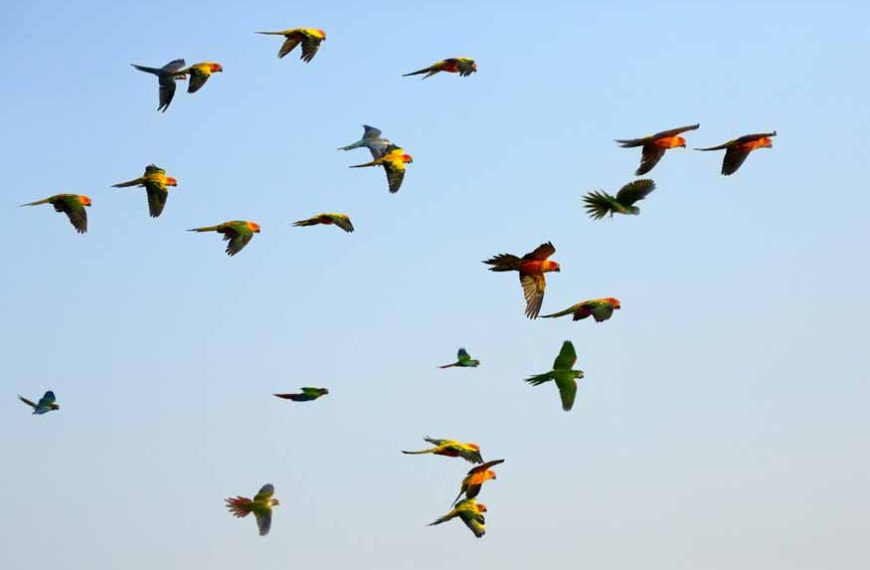Birds have always captivated us with their grace and beauty, but it’s their incredible journeys during migration that truly astonish. Each year, countless species embark on long, perilous voyages, showcasing nature’s resilience and adaptability. This blog delves into the fascinating world of migratory birds, exploring the reasons behind their migration, the variety and details of bird species involved, and the scientific explanations underpinning these remarkable journeys. So, here goes… A fun read on migratory birds and reason for their migration. Read on…
Understanding the Phenomenon: Why Do Birds Migrate?
Migration is a profound demonstration of nature’s rhythm, primarily driven by the instinct for survival. Birds embark on these extensive journeys to exploit rich, seasonally available resources. In the spring, they fly to regions rich in insect populations and ideal breeding conditions. Conversely, as winter approaches and food becomes scarce in their breeding grounds, they migrate to warmer areas where food is abundant. This cycle ensures their survival and reproductive success. Birds also migrate to avoid predators and diseases, which are more prevalent in certain regions at different times of the year. So, now you know why do birds migrate!
What is the scientific reason behind bird migration?
Bird migration is a complex phenomenon influenced by a multitude of environmental and biological factors. Environmental cues like changing temperatures, diminishing food supplies, and varying day lengths trigger the migratory behavior. Internally, birds are equipped with remarkable navigational skills. They use the Earth’s magnetic field, the position of the sun and stars, and even olfactory cues to find their way across vast distances. Genetically encoded instincts play a significant role, guiding even young birds on their first migration without guidance from experienced adults.
Variety of Birds and Bird Species in Migration
The diversity in migratory birds is a testament to nature’s adaptability. The sheer variety of birds is immense! Species like the Ruby-throated Hummingbird, weighing less than a coin, travel from North America to Central America, crossing the Gulf of Mexico in a single flight. The Arctic Tern makes the longest migration, traveling from its Arctic breeding grounds to the Antarctic and back each year. The Bar-headed Goose, meanwhile, astounds with its ability to fly over the Himalayas, reaching altitudes where oxygen levels are drastically low.
Birds Details: Adapting to the Journey
Migratory birds showcase a range of adaptations that are nothing short of miraculous. Prior to migration, many species undergo a process called hyperphagia, where they eat voraciously to build up fat reserves that serve as energy sources on their long journeys. Some birds, like the Blackpoll Warbler, undergo significant physiological changes to reduce the weight of their organs and increase muscle mass for better flight efficiency. Migratory birds also have highly efficient respiratory systems and specialized wing shapes to enhance their endurance and flight speed.
Types of Migrating Birds: A Closer Look
There are several types of migrating birds, each with unique patterns: Long-distance migrants, like the Swainson’s Hawk, travel from North to South America. Short-distance migrants move over shorter distances, often within a single country. Altitudinal migrants, common in mountainous regions like the Himalayas, move up and down mountains with the seasons. Irruptive migrants, like some finch species, migrate unpredictably, based on food availability.
The Indian Perspective: Migratory Birds in India
India’s varied landscapes, from the Himalayan highlands to coastal wetlands, make it a critical pitstop for numerous migratory bird species. These birds, including the elegant Siberian Crane and the vibrant Greater Flamingo, enrich India’s avian diversity. Their arrival and departure are not just a visual treat but are integral to maintaining ecological balance, assisting in pollination, and controlling insect populations. Their presence also contributes to the richness of local ecosystems and aids in environmental monitoring and conservation efforts.
Engaging with Nature: Bird Watching and Conservation
The phenomenon of bird migration provides a unique window for humans to connect with the natural world. Our relationship with nature can be strengthened and the need for conservation brought to light by watching these migratory birds, learning about birds and their habits, and acknowledging the difficulties they face. Threats to migratory birds include habitat loss, pollution, climate change, and collisions with artificial buildings. Maintaining biodiversity and ecological balance depends on protecting these birds and their habitats.
Impact of Climate Change on Bird Migration
Climate change is drastically altering the dynamics of bird migration, a concerning trend with far-reaching implications. Rising temperatures and shifting weather patterns are impacting migratory timings and routes. Birds are now arriving earlier in their breeding grounds and departing later, which can lead to mismatches in food availability. Some species are altering their traditional routes, leading to increased energy expenditure and survival challenges. Understanding and managing the impact of climate change on bird migration is critical for the conservation of these species and the ecological balance they contribute to.
Role of Technology in Studying Bird Migration
Advancements in technology have revolutionized our understanding of bird migration. GPS tracking devices, satellite imagery, and radar technology are now commonly used to monitor migratory patterns with remarkable precision. These tools help scientists gather detailed data on flight paths, stopover sites, and migration timings. Citizen science platforms, like eBird, allow birdwatchers to contribute observations, creating a rich, global database of bird movements. This technological leap not only enhances our knowledge but also aids in effective conservation strategies. By tracking migration patterns, researchers can identify critical habitats, understand the challenges faced by migratory birds, and work towards protecting these vital ecological corridors.
Bird migration is a majestic natural event, rich in scientific wonder and aesthetic splendor. These incredible journeys highlight the intricate connections within our global ecosystems and underscore the necessity of environmental stewardship. They remind us of the delicate balance of nature and our responsibility to safeguard it for future generations.
At EuroKids, we’re passionate about sparking a lifelong love for nature and exploration in children. We have carefully considered the curriculum and have created it to expose young students to the wonders of the natural world. We promote interest, observation, and respect for wildlife through engaging instruction, practical exercises, and outdoor outings. Our goal is to instill a sense of environmental consciousness in the future generation, giving them the information and motivation to actively protect the environment. To learn more about our specially crafted curriculum, do visit the EuroKids centre nearest to your home today!















